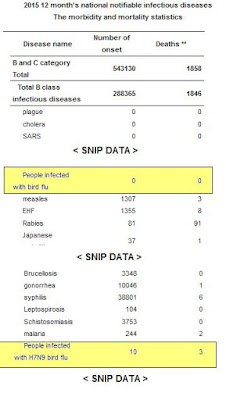#10,878
It's been nearly a month since the resource center of Epidemiosurveillance Santé Animale last posted an update on France's ongoing HPAI/LPAI bird flu outbreaks, but this morning they have released an epidemiological update as of 01/07/16.
Of 129 suspected outbreaks, 67 have tested positive for HPAI H5, 15 positive for LPAI H5, 45 proved negative, and 3 are still under investigation.
Of note, while 20 of the HPAI H5 viruses' neuraminidase was undetermined, of the remainder H5N9 was the most common subtype detected, followed by H5N1.
| Figure 6: Distribution of confirmed outbreaks of avian influenza by HP or insulated subtypes (France at 01/07/2016) |
Follow the link below for the full report, which includes numerous maps, charts, and graphs.
(Translated)
Suspicions and Avian Influenza H5 outbreaks in France - Point 2016-1 situation in 01/07/2016
Submitted by Vera Kant on 01/12/2016 - 9:31.
Sophie Le Bouquin (1), Adeline Huneau-Salaun (1), Rozenn Souillard (1), Manon Hamon (2) Matilda Saussac (3), Laure Bournez (3), Eric Niqueux (4), Audrey Schmitz (4) Jean-Yves Cough (1), Nicolas Eterradossi (4), Virginia Michel (1), Alexandre Fediaevsky (2), Didier Calavas (5), Pascal Hendrikx (3), Anne Bronner (2)
(1) Epidemiology Unit ANSES Ploufragan
(2) DGAl
(3) Unit UCAS, Anses, Laboratories Directorate
(4) Virology Unit, National Reference Laboratory, ANSES Ploufragan
(5) Epidemiology Unit Anses-Lyon
1. Summary of suspicions
On 7 January 2016, 129 suspected cases of influenza avian were investigated leading to the identification of 67 (52%) outbreaks influenza avian highly pathogenic subtype H5, 14 (11%) outbreaks of influenza avian LPAI subtype H5 (Figure 1); 45 suspicions were overturned and three are being analyzed.
As part of the monitoring, a suspected infection of livestock by a H5 influenza virus can be of origin:
o "Event": clinical signs of avian influenza observed in breeding,
o "analytic" from :
· the annual national survey of serological surveillance, where farming has positive serological results,
· the identification of epidemiological links between livestock and or proven outbreaks,
· screenings during movements provided of animals from livestock out of restricted areas.
These suspicions are reversed when H5 is not identified by PCR, or confirmed as H5 is present. In this case, the virus identified is qualified by a degree of pathogenicity, highly pathogenic (HP) or low pathogenic (LP).
HP avian influenza outbreaks were identified in seven departments (Figure 2). Four of them (Landes, Pyrénées-Atlantiques, Gers and Dordogne) comprise 92% of these homes.
Among the 126 investigated suspicions for which we have information, 58 (46%) were "Event" and 68 (54%) "analytical", making mostly a result of movements of animals before screening for outlet a restricted area (45 of 68, or 66% of analytical suspicions) (Table 1). About half of activation suspicions (43%) were confirmed (Figure 3), all for a subtype HP. As for screenings carried out under waivers for zone output, 42% (= 36/86) Waterfowl of farms in which samples were taken were found confirmed positive in HP, reflecting a significant contamination of the sector in restricted areas. All FP influenza cases have been identified from an original analytical suspicion.
(Continue . . .)

















 src="https://blogger.googleusercontent.com/img/b/R29vZ2xl/AVvXsEh4zgoKkY5esDyGDfXmhp5tz0W8H2jEgsRJx2wm9317hpr6CTdO8i4DPQj5mF-OAprw6GVcNt84Pt9Yp5U6XEz5h_pAP7azclFEO7kSUzDjr31IvLdzT01usqHnjVk1bBWsqpHQX6G4AIU/s1600/Photo0783.jpg" />
src="https://blogger.googleusercontent.com/img/b/R29vZ2xl/AVvXsEh4zgoKkY5esDyGDfXmhp5tz0W8H2jEgsRJx2wm9317hpr6CTdO8i4DPQj5mF-OAprw6GVcNt84Pt9Yp5U6XEz5h_pAP7azclFEO7kSUzDjr31IvLdzT01usqHnjVk1bBWsqpHQX6G4AIU/s1600/Photo0783.jpg" />












